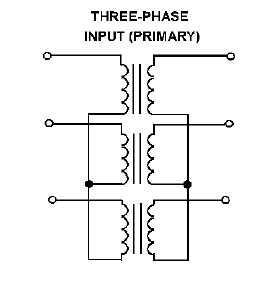3-13
Figure 3-11 shows three single-phase transformers connected wye-wye. Again, note that the
transformer windings are not angled. Electrically, a Y is formed by the connections. The lower
connections of each winding are shorted together. These form the common point of the wye. The opposite
end of each winding is isolated. These ends form the arms of the wye.
Figure 3-11.—Three single-phase transformers connected wye-wye.
The ac power on most ships is distributed by a three-phase, three-wire, 450-volt system. The single-
phase transformers step the voltage down to 117 volts. These transformers are connected delta-delta as in
figure 3-10. With a delta-delta configuration, the load may be a three-phase device connected to all
phases; or, it may be a single-phase device connected to only one phase.
At this point, it is important to remember that such a distribution system includes everything between
the alternator and the load. Because of the many choices that three-phase systems provide, care must be
taken to ensure that any change of connections does not provide the load with the wrong voltage or the
wrong phase.
Q14. In a three-phase alternator, what is the phase relationship between the individual output voltages?
Q15. What are the two methods of connecting the outputs from a three-phase alternator to the load?
Q16. Ships’ generators produce 450-volt, three-phase, ac power; however, most equipment uses 117-
volt, single-phase power What transformers and connections are used to convert 450-volt, three-
phase power to 117-volt, single-phase power?
FREQUENCY
The output frequency of alternator voltage depends upon the speed of rotation of the rotor and the
number of poles. The faster the speed, the higher the frequency. The lower the speed, the lower the
frequency. The more poles there are on the rotor, the higher the frequency is for a given speed. When a
rotor has rotated through an angle such that two adjacent rotor poles (a north and a south pole) have
passed one winding, the voltage induced in that winding will have varied through one complete cycle. For
a given frequency, the more pairs of poles there are, the lower the speed of rotation. This principle is


